Technology evolution, novel optics, and electronic components drive the adaptation of optical combs for spaceborne missions, setting up the conditions for future applications in vehicles and industry.
PATRIZIA KROK, BENJAMIN SPRENGER, AND FREDERIK BÖHLE, MENLO SYSTEMS GMBH
Optical frequency combs (OFCs) measure the oscillations of light
directly, delivering a level of precision superior to any other measurement technique1. This feature of direct measurement is being exploited in applications ranging from metrology to quantum computation, and the user community is continuously expanding, along with the market and a growing selection of OFC manufacturing companies.
Naturally, as OFCs conquer new territories, new users — not necessarily from academic backgrounds — increasingly demand “black box” character and push-button operation.
Is the optical frequency comb ready to meet these requirements? The technology readiness level (TRL) system, introduced by the NASA in the 1970s, enables rapid assessment of technology maturity. In the two decades since the introduction of OFCs to the market, the technology has evolved to reach a high readiness level in aerospace projects, promising extended benefits for a broad variety of real-world applications.
Optical frequency comb principles
OFCs are emitted by mode-locked femto-second lasers. Consecutive pulses of the laser pulse train in the time domain can be described in terms of a Fourier series, which corresponds to a series of frequency modes in the frequency domain (Figure 1). The separation between modes is equal to the repetition frequency ƒr, and the comb modes are shifted by an arbitrary offset frequency ƒ0, the carrier-envelope offset (CEO) frequency.
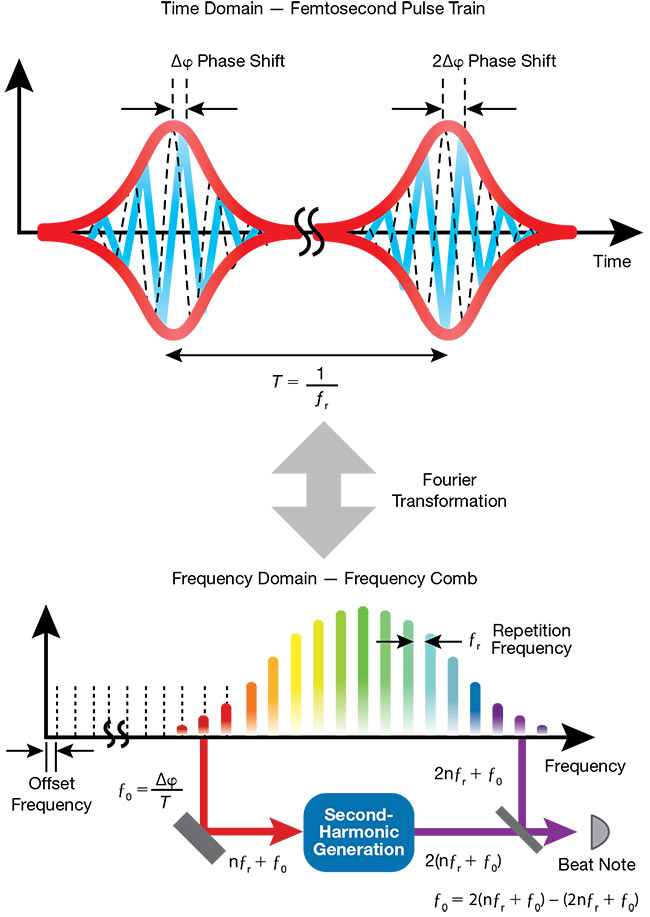
Figure 1. The principles of optical frequency combs (OFCs). Courtesy of Menlo Systems.
The frequency of each mode can be written as:
ƒn = nƒr + ƒ0.
This equation maps two radio frequencies, ƒr and ƒ0, onto the optical frequency ƒn (n being an integer). When the repetition frequency and the offset frequency are known and stabilized, the frequency comb represents a ruler in the frequency domain.
A photodiode measures the repetition frequency ƒr, which usually lies between a few tens of megahertz and a few gigahertz. With a comb spanning more than an octave, it is particularly easy to determine the offset frequency ƒ0. A mode with the number n at the red end of the spectrum is sent through a nonlinear crystal to generate its second-harmonic frequency, which is displaced by twice the offset frequency. A beat note between this frequency-doubled mode and an original comb mode with the number 2n at the blue end of the spectrum directly reveals the offset frequency:
ƒ0 = 2(nƒr + ƒ0) − (2nƒr + ƒ0).
In practical terms, actively stabilizing the length of the oscillator cavity defines the repetition frequency ƒr, and active dispersion control within the cavity stabilizes the offset frequency ƒ0. Depending on the design of the comb oscillator, external perturbations might hamper the stabilization on various timescales.
Evolving system technology
Over the last 20 years, optical frequency combs have evolved for practical use. The first and most important milestone was the transition from comb oscillators based on Ti:sapphire lasers to a fiber-based laser platform. Whereas the free-space optics of the bulk crystal laser system typically require a laser physicist to perform frequent alignment and occasional cleaning, spliced fiber components considerably reduce the maintenance effort.
Increasing the optical power of the single comb modes within the spectrum was another milestone because it simplified operation — for example, when searching for the beat note of a continuous-wave laser with the closest neighboring comb mode. To condense the available spectral
power into fewer modes, the spectral spacing of the modes is increased.
Modern combs therefore come with a repetition rate of 250 MHz, or even up
to the gigahertz range, compared to the 100-MHz repetition rate of early models.
Another successful replacement of free-space optics by suitable fiber components has led to considerably more robust and long-term stable comb operation. Stable comb operation depends on reliable generation and detection of the CEO frequency, performed in the ƒ-2ƒ interferometer (Figure 1). The interferometer requires an octave-spanning optical supercontinuum spectrum, frequency doubling of its red end portion, and overlapping of these two on a photodiode. Drifts in the free-space optical components degrade the CEO beat note. In a waveguide ƒ-2ƒ interferometer, the optics are spliced and therefore considerably more robust. Moreover, confining the supercontinuum and frequency doubling within the boundaries of an optical fiber ensures a stable CEO beat note.
Advancements in laser mode locking have improved performance as well. A common technique for active fiber laser mode locking is polarization rotation using several waveplates, with individual adjustments leading to essentially stable mode-lock states. This adjustment can be time-consuming, and the moving parts tend to drift over time. Instead, passive polarization mode locking using polarization-maintaining optical fibers and the nonlinear optical loop mirror (NOLM)2 eliminates moving parts. It has only one mode-lock state and therefore is as easy to use as a light bulb. Compared to other passive mode-locking mechanisms, such as saturable absorbers, the NOLM technique avoids degradation of components over time and ensures reliable self-starting mode locking. It enables stable comb operation even under environmental conditions that would normally be less laser-friendly or that would require additional effort, such as temperature shielding or active cooling, humidity control, or vibrational or acoustic system decoupling. Furthermore, the NOLM technique involves significantly lower phase noise compared with semiconductor saturable absorbers and polarization rotation mode-locking techniques3. The technology smooths the path for the industrial use of optical frequency combs and femtosecond fiber lasers in general.
Another CEO locking method stabilizes the comb at two frequencies instead of one and uses fast actuators, delivering ultralow phase noise and high stability throughout the comb spectrum rather than just in the area around the singular locking point. Moreover, CEO and repetition frequency locking are truly independent of each other and therefore very robust. The ultralow-noise technique enabled record stability4 and accuracy of the OFC, which makes it of interest for use in optical clock applications.
Implementing an embedded control
system, system automation, and a versa-
tile interface structure is important for creating compact systems with a high technology readiness level for easy integration. These developments are often driven by large-volume projects.
Space-compatible technology readiness
The transformation of the highly complex Ti:sapphire-based frequency comb into an easy-to-operate fiber-based system has also sketched the roadmap to the final frontier: space.
The urge toward space is motivated by a vast field of potential applications. OFCs can improve metrology systems by orders of magnitude compared to conventional systems. The new standard of accuracy will allow them to determine more precisely the gravitational redshift, for instance — not only to test Einstein’s equivalence principle but also to survey the gravitational field around Earth. An OFC in optical clocks or in reference and time distribution systems will enable a new generation of global navigation satellite systems that are more precise and resilient against outages.
OFC technology is also relevant for atmospheric trace gas detection, sensitive radar systems, satellite formation ranging, and other applications. This wide range of potential applications has attracted attention from space agencies and national and international institutions. In 2021, the Galileo Competence Center at the German Aerospace Center commenced the COMPASSO mission to test optical technologies on the International Space Station (Figure 2), with a projected launch in 2024. The mission aims to qualify novel photonics technology for use in space. The test system comprises an iodine reference, an OFC, and a laser terminal for integration into future generations of the Galileo systems and into scientific space missions5.
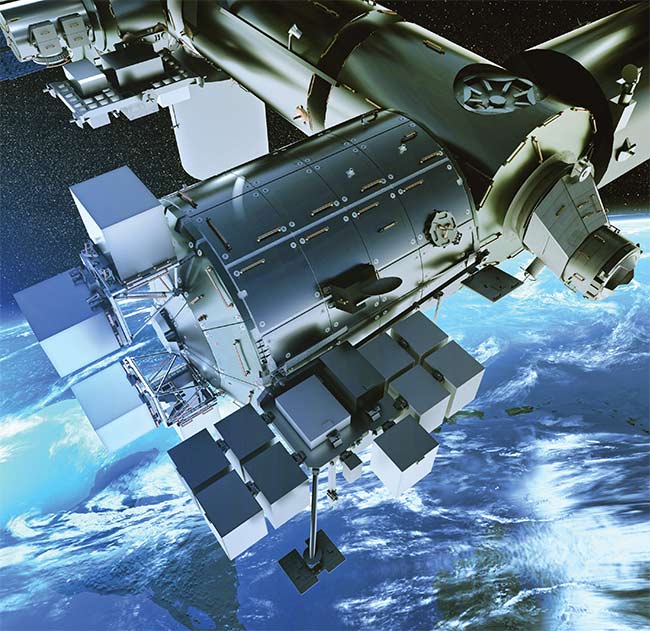
Figure 2. Europe’s Columbus module (center), part of the International Space Station, along with the Bartolomeo payload hosting platform. The OFC will operate from inside one of the boxes (bottom). Courtesy of Airbus.
The current commercial and scientific OFC systems were not developed for space use. They are far too bulky, power hungry, and unsuitable for the harsh environmental conditions. Endurance tests with OFCs on sounding rockets6 proved their suitability for operation under high vibration and shock loads, but a number of other parameters must be addressed to ensure long-term functionality in space.
For OFCs to endure the high vibration and shock load during the launch period, and for them to sustain the alignment of some indispensable and very sensitive free-space components, a new bonding method for optics elements was developed. It uses a low-melting-point solder, replacing the traditional bonding by adhesive or fixture mounting. Such bonds (Figure 3) provide the necessary high stiffness over a large thermal range to keep the optics in place. Moreover, they improve stability when exposed to vacuum and irradiation.
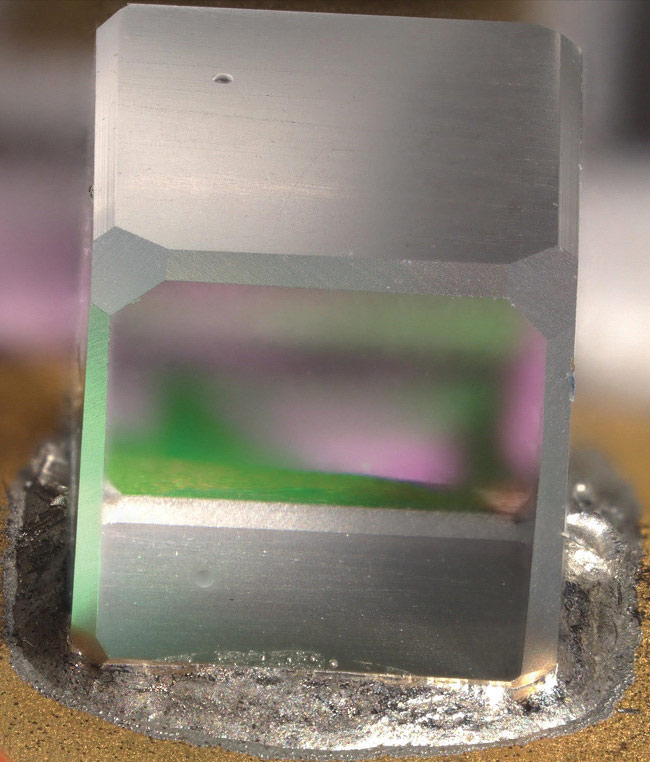
Figure 3. A mirror joined to a metalized surface via flux-free soldering to improve stability and stiffness over a wide thermal range. Courtesy of Menlo Systems.
Cosmic radiation is another roadblock that precludes the use of standard comb technology on satellites. Although the development of radiation-hardened electronics is a costly but well-established process in the space industry, the making of radiation-tolerant optical fiber is the subject of ongoing research. For instance, radiation-induced color centers increase the absorption of light within the fiber core. As the color centers accumulate, they deteriorate the performance of optical oscillators and amplifiers. Recently, a frequency comb oscillator and amplifier system built with a newly developed radiation-tolerant erbium-doped fiber was operated under intense irradiation by a Cobalt-60 source and showed a tenfold increase in lifespan as compared with a conventional system7.
Besides the advancements made to address the environmental challenges, the size, weight, and power (SWaP) profile of the OFC system for the COMPASSO mission was substantially reduced. In addition, a new operational concept enables the system to operate autonomously. The compact, sealed device has only a few standard connector interfaces for electronics and optics. It does not bear any resemblance to the early OFC platform with free-space optics (Figure 4), particularly due to the absence of the 6-ft-high electronics rack that the early platform required for its operation.
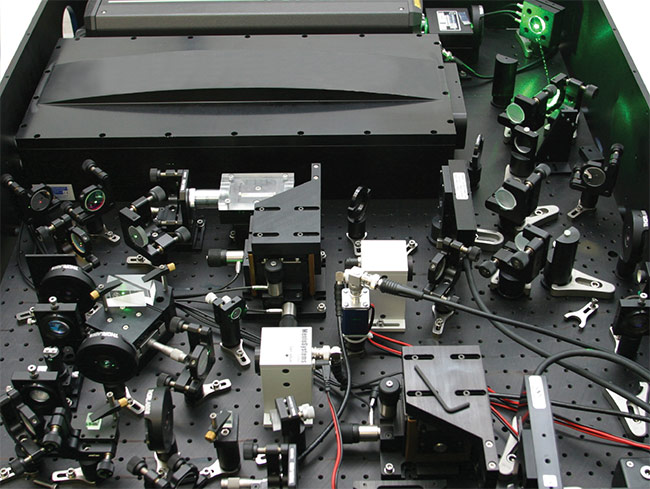
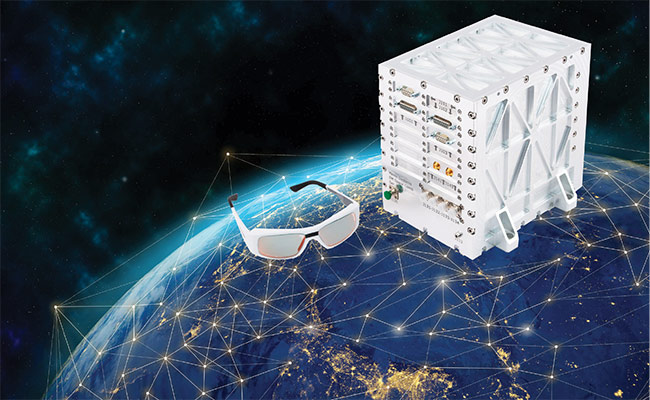
Figure 4. The optics of an early Ti:sapphire OFC (top) and the engineering model for the COMPASSO mission (bottom). Courtesy of Menlo Systems.
The technology developed for the space-qualified frequency comb — along with its environmental robustness, low SWaP profile, and ease of operation — opens the path for its application in harsh environments, such as on vehicles (maritime, land, and air), at remote sites, and in industrial machinery.
Meet the authors
Patrizia Krok, Ph.D., has been working in sales and marketing at Menlo Systems GmbH since 2010. She holds a doctorate in quantum optics, and her postdoctoral research focused on femtosecond spectroscopy; email: [email protected].
Benjamin Sprenger, Ph.D., is regional manager at Menlo Systems GmbH, covering frequency combs and cavity-stabilized lasers. He has been with the company since 2015. Sprenger holds a doctorate in laser physics, and his postdoctoral research focused on quantum optics; email: [email protected].
Frederik Böhle, Ph.D., received his doctorate in 2017 from École Polytechnique in
Palaiseau, France, for his work on high-
intensity lasers and attosecond spectroscopy. Since then, he has been developing space-qualified optical frequency combs at Menlo Systems GmbH: email: [email protected].
References
1. M. Giunta et al. (2019). 20 years and 20 decimal digits: a journey with optical
frequency combs. IEEE Photon Technol Lett, Vol. 31, p. 1898.
2. W. Hänsel et al. (2017). All polarization-
maintaining fiber laser architecture for robust femtosecond pulse generation.
Appl Phys B, Vol. 123, p. 41.
3. N. Raabe et al. (2017). Excess carrier-envelope phase noise generation in saturable absorbers. Opt Lett, Vol. 42, p. 1068.
4. E. Oelker et al. (2019). Demonstration of
4.8 × 10−17 stability at 1 s for two independent optical clocks. Nat Photonics, Vol. 13, p. 714.
5. T. Schmidt et al. (2022). COMPASSO:
in-orbit verification of optical key technologies for future GNSS. Proc 53rd Annual Precise Time and Time Interval Systems and Applications Meeting, Long Beach, Calif., p. 158.
6. B.J. Pröbster et al. (2021). FOKUS II — Space flight of a compact and vacuum compatible dual frequency comb system.
J Opt Soc Am B, Vol. 38, No. 3, p. 932.
7. M. Lezius et al. (2022). Radiation tolerant frequency comb fiber laser for space appli-
cations. Proc SPIE, Vol. 11997, Optical Components and Materials XIX, 119970G.